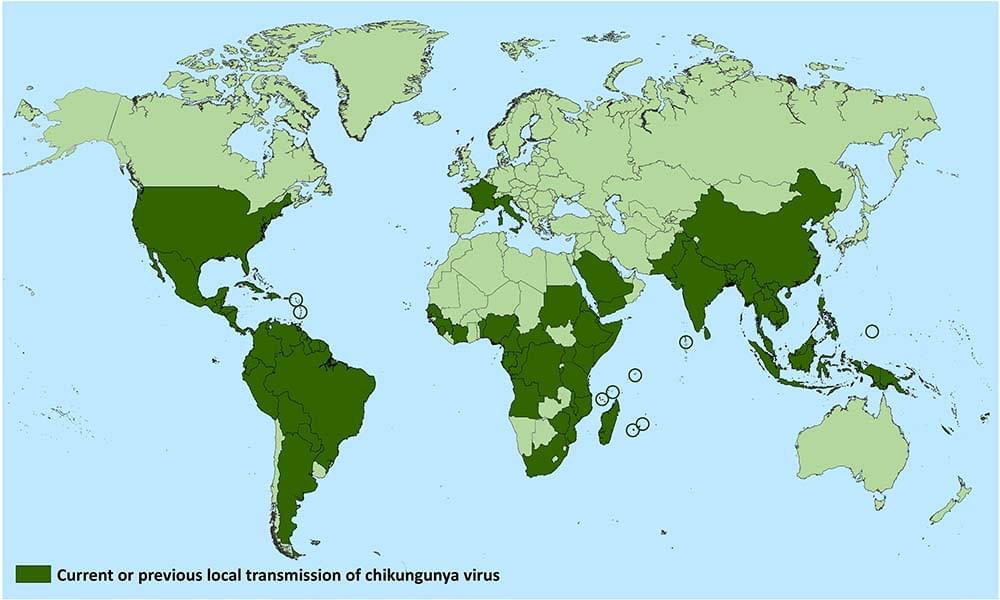Chikungunya
Chikungunya is a mosquito-borne viral disease first described in Tanzania in 1952. Although a typically tropical disease, Chikungunya is also expanding rapidly in other parts of the world where it was previously unknown, due in part to climate change (which facilitates the presence of vector mosquitoes), urbanisation, and intercontinental travel.
The name “chikungunya” comes from a word in the Kimakonde language, meaning “bone breaker” or “to become contorted”, and describes the stooped appearance of sufferers with joint pain.
CAUSES
The infection is caused by Chikungunya a single-stranded RNA virus (CHIKV), an Alphavirus genus of the Togaviridae family. The primary vectors of the disease are mosquitoes of the Aedes genus. Characterised by their black bodies with white stripes and the fact that they are active both day and night, these two species are also involved in the spread of other dangerous diseases, such as yellow fever and dengue. Aedes aegypti is the main vector and is usually found in tropical and sub-tropical regions. Aedes albopictus is known as the "tiger mosquito”, which is found in the more temperate regions of Europe, Asia, and Africa.
TRANSMISSION
The transmission cycle of the disease revolves around the mosquito bite. After coming into contact with the virus by feeding on the blood of an infected animal, the mosquito becomes a carrier for life and subsequently transmits the disease when they feed. In the wild, the main reservoir is typically, but not exclusively, the monkey, while during epidemics it is humans.
Transmission of the virus from the infected person is most likely to occur within the first 2-6 days of the acute phase. This most commonly occurs via human-mosquito transmission, but human-to-human contagion is also possible with direct contact with infected blood or via vertical transmission from mother to foetus during pregnancy.
GEOGRAPHICAL DISTRIBUTION
Chikungunya virus has been identified in more than 60 countries throughout Asia, Africa, Europe and the Americas. Italy holds a grisly record in the spread of the disease: the first autochthonous outbreak (i.e., local cases of the disease not contracted during travel) in Europe was recorded between July and September of 2007, in Emilia-Romagna, which caused over 200 cases.
The global distribution of Chikungunya shows that the virus is expanding at an accelerated rate due to multiple factors, such as climate change and the subsequent spread of the vector mosquito, urbanisation, and intercontinental travel, which can cause disease outbreaks, even in areas that had never experienced it before.

Fonte: CDC
SYMPTOMS
The incubation period of Chikungunya is usually 3 to 7 days after the bite, but can also range from 1 to 12 days. Usually, the onset of the disease is characterised by the fever (over 39 °C), accompanied by severe, debilitating joint pain. Other symptoms may include headache, muscle pain, arthritis, nausea, and maculopapular rash (similar to measles).
Most patients usually recover completely after a week, but in some cases joint pain may persist for several months or even years.
More rare symptoms include uveitis, retinitis, myocarditis, hepatitis, nephritis (inflammation of the kidneys), haemorrhage, meningoencephalitis, myelitis, Guillain-Barré syndrome, and cranial nerve palsy. More serious complications are rare, but possible, particularly in people at risk, such as infants exposed during childbirth, the elderly (over 65), and people with conditions, such as hypertension, diabetes, or heart disease.
DIAGNOSIS
Suspicion of a case of Chikungunya may arise during clinical examination of the patient, through observation of the symptoms, or from their medical history (e.g., recent travel to an endemic area).
Generally, virus detection is based on the search for viral nucleic acid or specific immunoglobulin and neutralising antibodies. Serological tests, such as enzyme-linked immunosorbent assays (ELISAs), can confirm the presence of anti-chikungunya IgM and IgG antibodies. IgM antibody levels are highest 3 to 5 weeks after disease onset and persist for about 2 months.
The virus can be isolated in the blood during the first few days of infection. Various reverse transcriptase-polymerase chain reaction (RT-PCR) methods are available, but have variable sensitivity. RT-PCR products from clinical samples can also be used for virus genotyping, allowing for comparison with virus samples from various geographic sources.
TREATMENT
There is no specific antiviral treatment for chikungunya, and there is no commercial vaccine. Treatment is mainly aimed at relieving symptoms, including joint pain and supporting vital functions.
The CDC recommends drinking plenty of fluids and the use of acetaminophen (paracetamol) to reduce fever and pain. The use of aspirin, or other nonsteroidal anti-inflammatory drugs, is not advised until Dengue has been ruled out.
PREVENTION
Prevention of Chikungunya transmission starts with appropriate preventive behavioural measures, especially during the day, when mosquitoes are most active.
- Use an effective mosquito repellent
The Centers for Disease Control and Prevention (CDC) recommend repellents with the following active ingredients: DEET (>25%); Picaridin; IR3535; Oil of Lemon Eucalyptus (OLE); Para-menthane-diol; 2- undecanone. - Keep covered
Wear clothes that cover the legs and arms; light-coloured clothing is best. - Check the surrounding environment
Stagnant water is the perfect habitat for mosquitoes to breed. Make sure there is no stagnant water in discarded tyres or industrial containers, swimming pools, storm drains, plant pot saucers, etc. To reduce the risk of transmission, systematic pest control campaigns to fight the Aedes mosquito population appear to be an essential intervention. - Read our in-depth article Don't get bitten!




